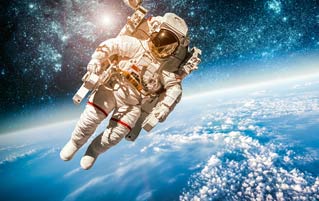5 BS Science Myths Your Entire View Of The World Rests On

Every child in the US -- save for the weirdo home school kids, and those being raised by wolves (not the only place those demographics overlap) -- must endure the public education system. Jaded teachers, shoveling facts hand over fist into generation after generation of rambunctious children and sullen teens until, at last, the students graduate and are free to believe whatever stupid crap they want. But it's all worth it, because at least you leave school knowing a few undeniable truths. Perhaps fewer than you think ...
False: Our Solar System's Planets Revolve Around The Sun

It's easy to look back to the past, and laugh at those morons who used to think that the sun revolved around the Earth. One of the first things you learn in school is that planets revolve around the sun - not the other way around - because the sun is the real star of our solar system, in every sense of the word. And yet that's not entirely accurate: Remember those solar system models, with the sun stuck on an immobile pillar, while all the other planets spin around it on wires? You know, every model of the solar system you've ever seen?

It's wrong, and so is that diorama your stupid kid made that won second place at the science fair, losing out to a baking soda volcano. In reality, the sun is just another orbiting object, which also rotates around the true center of the solar system, the barycenter. What's there? Nothing. Absolutely nothing.

Imagine Michelangelo throwing a pair of nunchucks at Bebop, because we're idiot man-children that must compare everything to a cartoon, and also because Ninja Turtles was never very big on realistic nunchaku combat. As the sticks fly through the air, they spin around, but one of them doesn't orbit the other one - they both orbit the middle point between them. The same thing happens between two bodies in space, except that the "chain" holding them together is gravity.
Of course, the solar system isn't just a big pair of nunchucks. The sun has eight planets - making it what we in the nunchaku world call an 'octochaku,' though our vows forbid us to speak more of it to outsiders -- so its orbit around the barycenter isn't a neat circle, but more of a complex wobble, as this video shows.
Is... is the Sun drunk?
False: You Know What A Desert Is

"Desert" seems like a pretty straight-forward geographical definition. It's the sandy place, one taunting 's' away from ice cream. If we say "jungle," you picture trees. If we say "desert," you picture dunes. So what's the biggest desert in the world? The Sahara? The Mojave? Donald Trump's withered ballsack? The answer is Antarctica.

Leopard Camel seal?
The definition of "desert" relies on the amount of annual rainfall a place receives - specifically, 15 inches or less. Antarctica falls well within that category. And you might be thinking this is just a case of semantics - "Of course it doesn't rain in Antarctica, it snows!" - but you'd still be wrong. It hardly ever snows in Antarctica. All that ice has built up over millions of years, and despite what you may have seen in the movies, the amount of fresh stuff that falls from the sky there is so miniscule that it's classified as the driest continent on Earth. It's less "winter wonderland" and more "parched hellscape."
If you're still not convinced, there are parts of Antarctica that receive so little snowfall they actually look the part of "desert." The Antarctic "Dry Valleys" -- the ones that exist between those tall, cloud-and-Cthulhu-blocking mountains -- look like this:

False: You Experience "Zero Gravity" In Open Space

Once your spaceship reaches a certain point beyond Earth's atmosphere, gravity disappears, and the astronauts start floating around in "zero gravity." They made a whole movie about it, aptly titled "Gravity," because calling it "Pointless Awkward Floating" makes it sound like a sequel to The Shallows.

In reality, there's actually no such thing as "zero gravity," no matter how far you venture into the final frontier. If you're on the top floor of a skyscraper that reaches as far into the atmosphere as your GPS satellite, you'd experience gravity just the same as if you were sitting in a Starbucks at ground level. And that makes perfect sense when you think about it - if gravity disappeared just a few miles above a planet's surface, then how does the Earth maintain gravitational influence over the moon? On that note, how can the sun keep its grip on something as far away as Pluto?
That said, the "floating" sensation experienced by astronauts isn't an elaborate prank on us gullible land dwellers. That really happens. But it's not because of lower gravity. What you're actually seeing when an astronaut floats across the room isn't an absence of gravity, so much as a skydive that never ends.

The ISS, for example, is in orbit around the Earth, and an orbit is simply a controlled fall. When you're in orbit around the Earth, you're basically just throwing yourself toward the ground and missing. Astronauts who experience "zero gravity" are actually in free-fall, experiencing the same physics as someone who jumps out of a plane, either in search of a fleeting thrill, or chasing an errant Patrick Swayze.
False: Magnets Are Responsible For ... Magnetism? Wait, Really?
"Magnets," a great philosopher once pondered. "How do they work?"
Most likely you know that the magical property of magnetism is something inherent to iron, and almost nothing else. That's why they trapped Magneto in a plastic prison in X-Men, which he only escaped by using the elevated iron in a man's blood - which was as awesome as it was scientifically incorrect.
See, everything is magnetic. Literally everything. If you don't believe us, check out this magnetic frog. With apologies to the frog.

Now obviously, some materials are more magnetic than others, which is why you can't pin your power bill to the refrigerator with a frog. Iron just happens to be the element with the strongest magnetic properties at room temperature. Magnetism is destroyed by heat, and for most things, the temperature of your average room is enough to revert, say, a potato, to its standard, non-magnetic form.
But when you cool things down, all sorts of materials are attracted to magnets, even including oxygen and nitrogen. So if it gets cold enough, Magneto could, in theory, have absolute power over frogs. Get on it, Marvel.

False: We Understand What Life Is

Scientists keep sending robots to other planets in the hope of discovering the answer to that great existential question: Does life exist elsewhere in the universe, and if so, could we bone it?
But here's a more basic question we should be asking: What is life?

That's easy, you might think. People, birds, magnetic super-frogs -- all living things. Chairs, rocks, Senator Ted Cruz -- all lifeless, unthinking, inanimate objects.
But it turns out that there's a considerable "gray area" between "alive," and "not alive," and for once, we're not talking about zombies. In fact, that gray area encompasses a large swath of the biosphere, at least on a smaller-than-visible level. For example, there's constant disagreement among scientists about whether or not viruses are alive. Viruses, such as those responsible for influenza, are different from bacteria, in the sense that they don't have cells, but they do have DNA, and they can still mess you up if they get into your body.

So they're alive, right? Not so fast! Viruses don't breathe, or eat, or anything else that's usually an indicator of a living organism. And they can exist forever in the wild because, if you're not alive in the first place, you can't die. The one thing they do that usually defines a "living thing" is reproduce. And they can only do that inside an already-living cell.
Right now, scientists are flirting with the idea that viruses fall into the "alive" category, but there are also viroids, which are organisms (?) that are even simpler than viruses, and mostly affect plants. Even below viroids, we have prions. Prions are basically just messed-up proteins, and they're responsible for exotic diseases like Mad Cow Disease. Are those bastards alive? Nobody really knows! Which is a big deal for medicine, because prions are like some sort of horrible reverse-Predator: if they're not alive, we can't kill them.

Scientist Martin Hanczyc has created some little chemical blobs that he calls "protocells," which move around, take in energy from the environment, and grow. Are they alive?
Oh, but this is all just fruitless rumination about tiny, invisible stuff. We don't need to stress about whether or not like, buffalo are alive. D-do we?

Scientists have found that the movement of buffalo herds can be pretty reliably predicted by the same rules that govern particles in a gas. And swarms of ants actually move very much like liquids. So to what degree is life that different to the inanimate crap that floats around us all day?
And holy crap, what if scientists find out that you behave strangely similar to like, an asteroid field? A gassy, lazy asteroid field? What does that mean for your life?
And on that note, we're going to go get high and stare at our own hands for a while.
Saikat Bhowmik is a kid who has grown a beard to look like a grown-up. He has a grown-up account at Twitter and a childish YouTube channel.
For more reasons to never trust anyone ever, check out 6 Lies About The Human Body You Learned In Kindergarten and 6 Ridiculous Lies You Believe About The Founding Of America.
Subscribe to our YouTube channel, and check out Why Everything You Know About Sleep Is A Lie, and other videos you won't see on the site!
Follow us on Facebook, and we'll follow you everywhere.
And to further straighten out your noggin, order Cracked's De-Textbook: The Stuff You Didn't Know About the Stuff You Thought You Knew.

